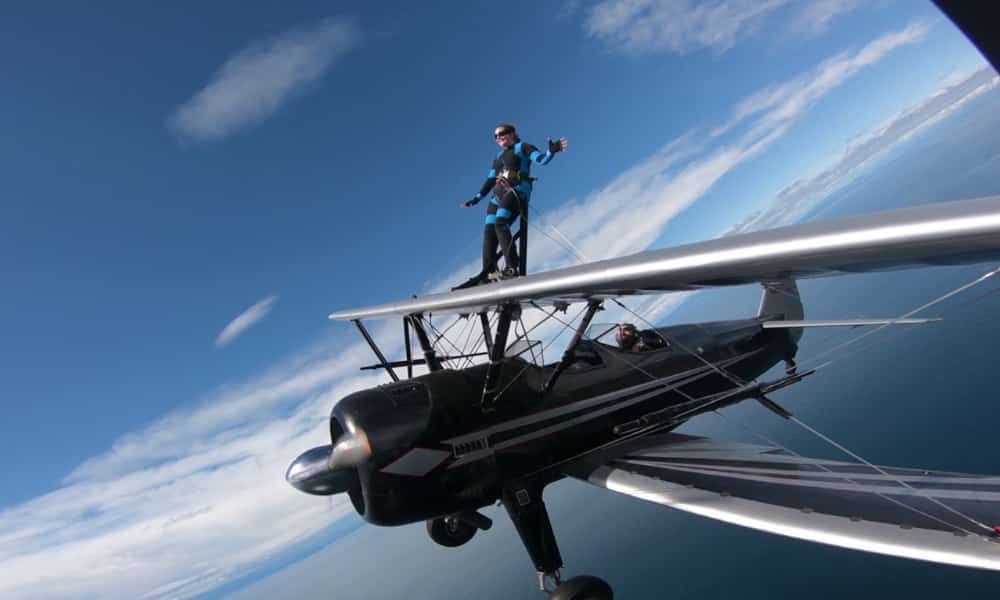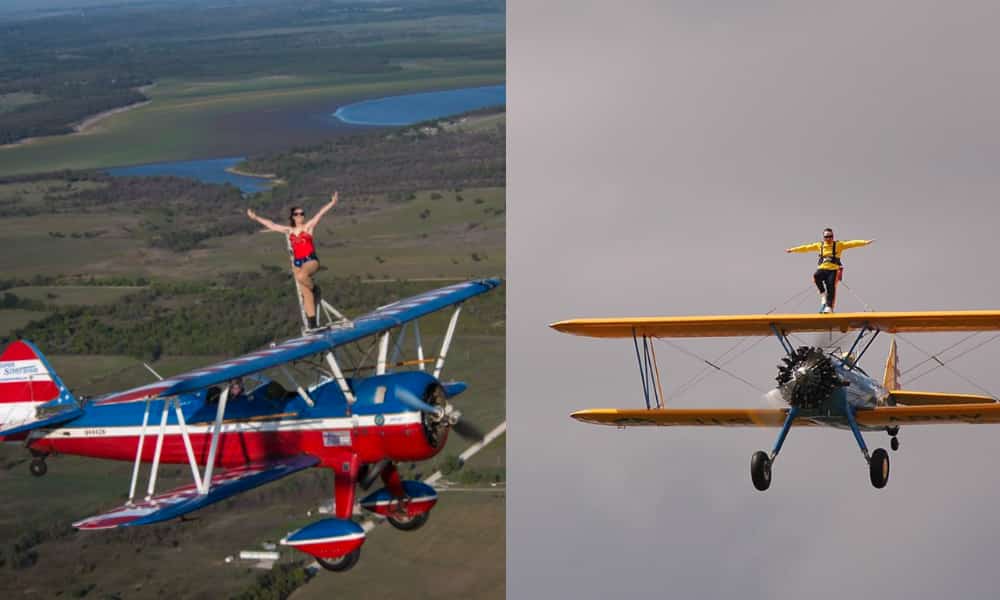If you are looking for information about what is wing walking? You are on the right blog. Wing walking stands among the most exhilarating aviation experiences available today. This comprehensive guide covers everything from safety protocols to pricing, helping you understand this remarkable aerial adventure.
What is Wing Walking?
Yes, wing walking is exactly what it sounds like. It involves standing or moving on the wings of a flying aircraft. The activity originated in the 1920s during the barnstorming era when daredevil performers would literally walk on biplane wings to entertain crowds at air shows.
Modern wing walking differs significantly from its historical roots. Today’s participants are securely strapped to metal frames attached to the aircraft wing. You don’t actually walk around freely like the original barnstormers did.
The experience uses vintage Boeing Stearman biplanes. These World War II-era training aircraft provide the perfect platform for this unique adventure. Pilots fly these classic planes at speeds between 80 to 150 miles per hour while you stand secured on the upper wing.

How is Wing Walking Performed?
The process begins with comprehensive ground training. Participants spend several hours learning safety procedures before ever leaving the ground.
Professional wing walking academies use a structured approach. You start by practicing movements on a stationary aircraft. The instructor teaches you hand signals for communicating with the pilot. You learn proper breathing techniques to handle the intense wind pressure.
Ground training includes climbing practice. You must navigate from the cockpit to the wing-mounted rig unassisted. This requires physical agility and strength.
Once airborne, the sequence follows a specific pattern. The pilot flies to altitude, typically between 1,000 to 3,500 feet. The aircraft enters a gentle glide. You climb from the cockpit onto the upper wing rack. The pilot secures you into the harness system using a five-point harness with backup safety pins.
After securing you properly, the pilot performs various maneuvers. These include flypasts, steep dives, zoom climbs, and banked turns. First-time participants typically don’t experience full aerobatics. Those come on subsequent flights once you’ve proven your ability to handle the experience.
The flight duration averages 10 to 25 minutes depending on the package. Some experiences include climbing to both upper and lower wing positions.
Wing Walking vs Wing Riding: Understanding the Difference
Wing walking and wing riding represent two distinct experiences. This distinction matters when choosing your adventure.
True wing walking involves training to move around the aircraft during flight. Participants at places like Mason Wing Walking Academy spend hours learning to climb between the cockpit and wing positions. They develop skills to navigate the aircraft exterior safely while airborne.
Wing riding takes a different approach. Participants strap into a fixed position on the wing before takeoff. You remain secured in that same spot throughout the entire flight. No climbing or movement occurs once you’re strapped in.
Most UK companies offer wing riding experiences rather than true wing walking. The experience delivers incredible thrills but requires less training and physical capability.

What Safety Measures Do Service Providers Follow?
Safety protocols in modern wing walking are extensive and strictly enforced.
Aircraft maintenance standards are rigorous. Operators maintain their vintage biplanes to the highest standards. Regular inspections occur before every flight. Experienced engineers with decades of combined experience handle all maintenance work.
The harness system provides multiple layers of protection. Participants wear a five-point harness system. A backup safety pin prevents accidental unlocking. The harness connects to reinforced mounting points on the aircraft. These attachment points undergo regular inspection for wear and structural integrity.
Pilots hold commercial licenses with extensive experience. Many have flown thousands of wing walking flights and performed at air shows worldwide. They undergo specialized training in wing walking operations.
Weather conditions receive careful monitoring. Operators check forecasts multiple times before flights. They cancel or reschedule if conditions aren’t suitable. Wind speed, visibility, and temperature all factor into go/no-go decisions.
Pre-flight briefings are mandatory. Every participant receives detailed safety instruction regardless of previous experience. The briefing covers emergency procedures, communication signals, and what to expect during flight.
Insurance coverage protects participants. Companies maintain public liability insurance ranging from £5 million to £10 million. Additional aircraft liability insurance covers all participants according to UK and EU legislation.
Medical screening identifies potential risks. Participants must complete health declarations. Certain medical conditions require doctor approval. These include epilepsy, heart conditions, high blood pressure, and diabetes among others.
Is Wing Walking Legal?
Yes, wing walking is legal with proper authorization and safety compliance. However, regulations vary by country.
In the United Kingdom, wing walking operates under Civil Aviation Authority regulations. Operators must obtain specific approvals to offer wing walking experiences to the public. Only a handful of companies hold the necessary certifications.
The United States has more restrictive regulations. In 2025, the FAA shut down Mason Wing Walking Academy, which was the only US facility offering true wing walking training to the public.
The closure eliminated civilian wing walking opportunities in America. Professional airshow performers can still conduct wing walking under different regulatory frameworks.
Operators must demonstrate compliance with safety standards. This includes aircraft airworthiness, pilot qualifications, insurance requirements, and operating procedures. Regular inspections and audits ensure continued compliance.
Is Wing Walking Dangerous? Understanding the Real Risks
Wing walking carries inherent risks, but modern safety measures have dramatically reduced dangers compared to the barnstorming era.
Historical context provides perspective. During the 1920s and 1930s, eight wing walkers died during the activity’s early years. Performers operated without parachutes, safety harnesses, or modern equipment.
Modern safety records show significant improvement. From 1975 to 2010, only two wing walkers died in the United States. Between 2011 and 2013, three fatalities occurred. With only about a dozen active wing walkers in the US during that period, the death rate remained low but not negligible.
Risk factors include equipment failure, pilot error, weather conditions, and participant health issues. Operators mitigate these through maintenance protocols, pilot training, weather monitoring, and medical screening.
The FAA acknowledges the apparent danger while noting actual safety. Spokespeople have stated that performers spend extensive time practicing away from crowds. When properly executed, the activity maintains reasonable safety margins.
Death rate statistics suggest wing walking ranks among extreme sports. Some sources cite a lethality rate of 3 deaths per 1,000 practitioners. This places it among the more dangerous adventure activities.
Modern wing riding experiences for first-time participants present lower risk than professional wing walking. You remain strapped in a fixed position. The aircraft flies at safer altitudes. Pilots avoid extreme maneuvers with inexperienced participants.
Is Wing Walking Scary? What to Expect Emotionally
Yes, wing walking is scary for most people. The experience generates intense emotional responses combining fear, excitement, and exhilaration.
The fear begins before takeoff. Watching the aircraft and understanding you’ll stand on top creates anticipation. The safety briefing reinforces the reality of what you’re about to attempt.
Physical sensations intensify the experience. Wind speeds of 80 to 150 miles per hour create hurricane-force pressure against your body. Participants describe it as “running a marathon in a hurricane.” Your face ripples. Your clothing whips violently. Breathing requires technique and concentration.
Height awareness affects many participants. Standing exposed at several hundred feet creates vulnerability unlike enclosed aircraft. You see the ground passing below with nothing but air between you and the earth.
G-forces add another dimension. During maneuvers, you experience positive and negative G forces. Your body feels heavier during climbs and lighter during descents. Some maneuvers create momentary weightlessness.
The overwhelming nature subsides for most people. Initial terror often transforms into pure adrenaline rush. Many participants report the experience as the most thrilling thing they’ve ever done.
Emotional reactions after landing run intense. Participants commonly experience euphoria, disbelief, and accomplishment. The emotional high can last for days.
Read Also: F-16 Ride Along
How Much Does a Wing Walking Experience Cost?
Pricing varies significantly based on location and experience package.
United Kingdom Pricing:
- Weekday wing riding experiences start at £400-£420
- Weekend and anytime experiences range from £419-£469
- Full day experiences at some locations reach £469
- Video recording packages cost an additional £50
United States Pricing (Historical):
- Mason Wing Walking Academy charged $850 for introductory upper wing courses
- Full-day upper and lower wing courses cost $1,250
- These options are no longer available following the 2025 FAA shutdown
Charity Events: Fundraising wing walks require minimum sponsorship commitments. These typically range from £500-£650. The participant pays a registration fee, usually £40-£50.
Additional Costs:
- Video and photo packages: £50
- Voucher extensions: £50
- Rescheduling fees: £40-£200 depending on timing
- Travel and accommodation costs are not covered if weather causes cancellations
Package inclusions typically cover the safety briefing, flight time, certificate of completion, and viewing area for spectators. Photos and videos cost extra at most locations.
Wing Walking Weight Limits and Physical Requirements
Operators enforce strict physical requirements for safety reasons.
Weight Restrictions:
- UK operators: Maximum 14 stone (196 pounds/89 kilograms)
- Some locations have lower limits: 12 stone (77 kilograms) to 13.3 stone (85 kilograms)
- US operations historically allowed up to 230 pounds (104 kilograms)
- Weight includes clothing and footwear
- Participants are weighed on the day; exceeding limits results in flight denial
Height Restrictions:
- Maximum height: 6 feet 2 inches (188 centimeters)
- Waist measurement: 40 inches or less when wearing warm clothing
Age Requirements:
- Minimum age: 18 years
- Maximum age: 80 years at some operators
- No upper age limit at others
- Participants aged 65-80 may require medical certificates
Physical Capability:
- Must climb unassisted approximately 10 feet (3 meters) from ground to wing
- Requires high leg lifts over cockpit sides
- Need upper body strength to pull yourself up using struts and wires
- Must withstand wind pressures at speeds up to 150 miles per hour
Medical Restrictions:
Participants cannot fly if they suffer from:
- Epilepsy or recurring fits
- Severe head or neck injuries
- Recurrent blackouts or fainting
- Heart or lung disease
- High blood pressure (uncontrolled)
- Diabetes (Type 1, or uncontrolled Type 2)
- Mental health conditions (unmedicated)
- Drug or alcohol addiction
- Pregnancy
If conditions are controlled through medication and regular doctor monitoring, operators may allow participation with medical certification.
Wing Walking Events and Airshows in the US
Finding wing walking events in America has become challenging following regulatory changes.
Professional wing walking acts still perform at select air shows. These performances feature trained aerobatic teams rather than public participation opportunities.
Major air shows that may feature wing walking displays include:
- EAA AirVenture Oshkosh
- Wings Over Wayne Air Show
- Pacific Airshow Huntington Beach
- Various regional aviation events
These events showcase professional pilots and wing walkers. Spectators watch from the ground but cannot participate in wing walking activities.
The 2025 closure of Mason Wing Walking Academy eliminated civilian training options. Anyone seeking hands-on wing walking experience must now travel to the United Kingdom or other international locations.
Air show calendars change annually. The International Council of Air Shows maintains listings of events featuring various aviation demonstrations. Individual air shows announce their performer lineups several months in advance.
Read Also: Average Speed of Fighter Jets
Where Can You Experience Wing Walking Today?
Geographic options have become limited, particularly for true wing walking training.
United Kingdom Locations:
Multiple companies operate wing riding experiences at airfields throughout England:
- Headcorn Aerodrome (Kent)
- Henstridge Aerodrome (Somerset/Dorset border)
- Rendcomb Airfield (Gloucestershire)
- Wickenby Aerodrome (Lincolnshire)
- Sywell Aerodrome (Northamptonshire)
Operating seasons run from March through October. Weather-dependent scheduling requires flexibility.
United States:
No public wing walking training facilities currently operate following the 2025 Mason Wing Walking Academy closure. Professional opportunities exist only for those joining established airshow teams.
International Options:
Other countries may offer wing walking experiences, though they remain rare globally. The UK maintains the most developed infrastructure for public participation.
Preparing for Your Wing Walking Experience
Success requires proper preparation both physically and mentally.
Physical Preparation: Start exercising several weeks before your booking. Focus on upper body strength and cardiovascular fitness. Practice climbing movements if possible.
Clothing Requirements:
- Tight-fitting clothing only (leggings, fitted pants)
- No loose garments, hoodies, or baggy clothing
- Laced trainers with soft, grippy soles
- Multiple warm layers for cold weather
- Goggles and earplugs (usually provided)
Weather Considerations: Wing walking requires specific weather conditions. Operators cancel flights in strong winds, rain, or poor visibility. Temperature minimums exist due to wind chill factors.
Book during summer months (June-August) for the highest probability of favorable weather. Allow flexibility in your schedule for potential rescheduling.
Mental Preparation: Research thoroughly to understand what you’re undertaking. Watch videos of wing walking experiences. Read first-hand accounts.
Accept that fear is normal and expected. Focus on the training you’ll receive and the safety systems in place.
Day-of Timeline:
- Arrive at the appointed time for your safety briefing
- Allow minimum 2 hours between briefing and flight
- Total time on-site: 2-4 hours
- Actual flight time: 10-25 minutes
Spectators: Most locations welcome friends and family to watch. Viewing areas provide good vantage points for photography. Some airfields have cafés and facilities for guests.
The Historical Significance of Wing Walking
Understanding wing walking’s history enriches appreciation for the modern experience.
Ormer Locklear pioneered wing walking in 1918. An American military pilot, Locklear first climbed onto his aircraft wing to fix a mechanical problem mid-flight. He recognized the entertainment potential and began performing publicly.
The 1920s barnstorming era saw wing walking explode in popularity. Following World War I, surplus military aircraft became available cheaply. Former military pilots formed traveling air shows called flying circuses.
Wing walkers competed to create ever more dangerous stunts. They performed handstands, hung by their teeth, and transferred between moving aircraft. Some walked from planes to trains, cars, or boats.
Female performers made significant contributions. Lillian Boyer, Gladys Ingle, and Mabel Cody numbered among dozens of women who became professional wing walkers. Bessie Coleman, the first African-American woman to hold an international pilot license, also performed wing walking stunts.
The practice declined in the mid-20th century. The 1929 stock market crash ended many flying circuses. In 1936, the U.S. government banned wing walking below 1,500 feet. This restriction made performances difficult for ground spectators to see.
The 1970s brought revival. New safety equipment enabled performers to return to airshows with reduced risk. Modern harnesses, communication systems, and improved aircraft made the activity safer than ever before.
Today’s wing walking honors aviation heritage while maintaining strict safety standards. The experience connects participants to the daredevil spirit of early aviation pioneers.
Conclusion
Wing walking represents one of aviation’s most unique experiences. Modern safety measures have transformed this once-deadly stunt into an accessible adventure for physically fit individuals.
The experience combines historical significance with pure adrenaline. Standing on a biplane wing at 100 miles per hour creates memories that last a lifetime.
Whether you choose a wing riding experience in the UK or watch professional performers at air shows, wing walking continues to captivate audiences and participants alike. The blend of vintage aircraft, skilled pilots, and human courage creates something truly special.
For those meeting the physical requirements and willing to embrace the challenge, wing walking offers an unmatched aviation adventure. Research operators thoroughly, prepare properly, and approach the experience with both respect for the risks and excitement for the incredible opportunity ahead. For more information, visit Crew Daily.


